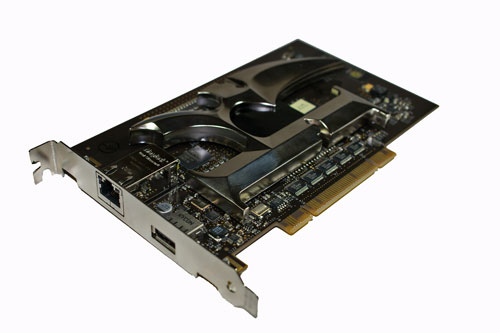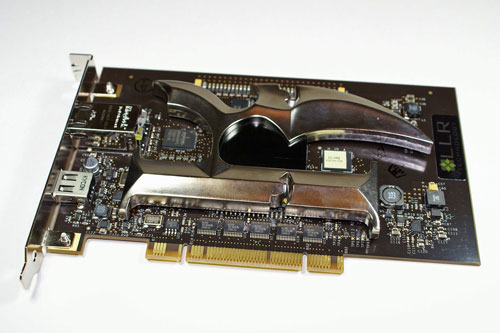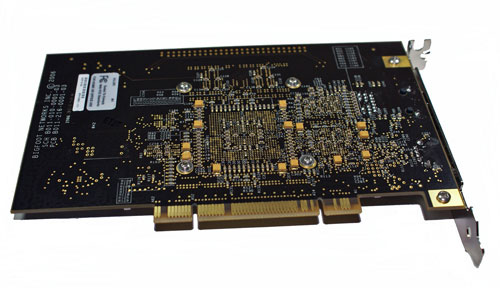BigFoot Networks Killer NIC: Killer Marketing or Killer Product?
by Gary Key on October 31, 2006 2:00 AM EST- Posted in
- Networking
Killer NIC Card
The Killer NIC ships with an installation disc that includes several Linux programs, a few decals, product documentation package, and a full retail copy of F.E.A.R. on DVD.
The Killer NIC is a very interesting card and since the Halloween season is upon us we have to say the thought of removing the "K" heatsink and using it as part of our Blade costume came to mind several different times. The PCB is black in color and contains a significant amount of components that you would never expect to see on a typical NIC. There are also several red LEDs on the PCB whose blinking movements can be adjusted by the control panel. Overall, the card's design theme follows its naming convention.
The card is equipped with a Freescale MPC8347E communications processor, a Xilinx Spartan FPGA, an integrated Broadcom Gigabit PHY, and 64MB of RAM for the embedded Linux build that is accessed by the FNapp Console. The Freescale MPC8347E communications processor is designed for general communications requirements from Ethernet routers to Internet network appliances. The Xilinx Spartan FPGA is a programmable gate array that houses Bigfoot Networks' proprietary and patent pending algorithms that also utilize the 64MB of onboard RAM.

The card utilizes a standard RJ-45 port and includes a USB 2.0 port. The USB 2.0 port is not visible to Windows and is designed to be used by an FNapp. The thought process is that an FNapp can read or write data to a flash drive or external HD. This would be very advantageous for writing data directly to an external hard drive via a BitTorrent type FNapp as one example.
The amount of integrated components along with its basic design features is one of the reasons why this card costs $279.99. This is a price tag that generally puts this card out of reach for most users who are typically satisfied with their NIC's current performance.
The card was very easy to set up. You need to disable your current NIC for optimum performance and compatibility. This is an action that we highly advise after a couple of aborted installs with the original driver set. The card requires a single PCI 2.2 slot and is only compatible with 32-bit Windows XP at this time. After installing the card, a quick reboot, and hardware recognition by XP, you install the driver set off the CD although we highly suggest downloading the latest release first. Another reboot is required and then you are set to use the card for total world domination. Well, at least this is probably your thought process if you read through the marketing material and other documentation online.
Additional 64-bit XP and Linux support is expected within the next six to eight weeks. However, it is still uncertain as to what features will be enabled for Linux and what if any performance benefits will be gained. Windows Vista support should be available by the time the OS ships and it will be interesting to see if there are any improvements considering Microsoft has completely rewritten the network stack code for efficiency and latency reduction. At this point in time there are no plans for a PCI Express version of the Killer NIC. According BigFoot Networks the PCI interface was utilized to improve transactional latencies, programming familiarity, and the fact that most systems have the required amount of PCI slots. We disagree with that last point as the majority of performance oriented boards are now PCI slot starved, and we would expect PCI-E to be a future consideration depending on the success of the current design.
The Killer NIC ships with an installation disc that includes several Linux programs, a few decals, product documentation package, and a full retail copy of F.E.A.R. on DVD.
 |
 |
| Click to enlarge |
The Killer NIC is a very interesting card and since the Halloween season is upon us we have to say the thought of removing the "K" heatsink and using it as part of our Blade costume came to mind several different times. The PCB is black in color and contains a significant amount of components that you would never expect to see on a typical NIC. There are also several red LEDs on the PCB whose blinking movements can be adjusted by the control panel. Overall, the card's design theme follows its naming convention.
The card is equipped with a Freescale MPC8347E communications processor, a Xilinx Spartan FPGA, an integrated Broadcom Gigabit PHY, and 64MB of RAM for the embedded Linux build that is accessed by the FNapp Console. The Freescale MPC8347E communications processor is designed for general communications requirements from Ethernet routers to Internet network appliances. The Xilinx Spartan FPGA is a programmable gate array that houses Bigfoot Networks' proprietary and patent pending algorithms that also utilize the 64MB of onboard RAM.

The card utilizes a standard RJ-45 port and includes a USB 2.0 port. The USB 2.0 port is not visible to Windows and is designed to be used by an FNapp. The thought process is that an FNapp can read or write data to a flash drive or external HD. This would be very advantageous for writing data directly to an external hard drive via a BitTorrent type FNapp as one example.
The amount of integrated components along with its basic design features is one of the reasons why this card costs $279.99. This is a price tag that generally puts this card out of reach for most users who are typically satisfied with their NIC's current performance.
The card was very easy to set up. You need to disable your current NIC for optimum performance and compatibility. This is an action that we highly advise after a couple of aborted installs with the original driver set. The card requires a single PCI 2.2 slot and is only compatible with 32-bit Windows XP at this time. After installing the card, a quick reboot, and hardware recognition by XP, you install the driver set off the CD although we highly suggest downloading the latest release first. Another reboot is required and then you are set to use the card for total world domination. Well, at least this is probably your thought process if you read through the marketing material and other documentation online.
Additional 64-bit XP and Linux support is expected within the next six to eight weeks. However, it is still uncertain as to what features will be enabled for Linux and what if any performance benefits will be gained. Windows Vista support should be available by the time the OS ships and it will be interesting to see if there are any improvements considering Microsoft has completely rewritten the network stack code for efficiency and latency reduction. At this point in time there are no plans for a PCI Express version of the Killer NIC. According BigFoot Networks the PCI interface was utilized to improve transactional latencies, programming familiarity, and the fact that most systems have the required amount of PCI slots. We disagree with that last point as the majority of performance oriented boards are now PCI slot starved, and we would expect PCI-E to be a future consideration depending on the success of the current design.










87 Comments
View All Comments
stmok - Tuesday, October 31, 2006 - link
Yeah, I do agree.Its targetting at the wrong crowd. This product should be really for the hardcore enthusiasts. (I'm talking about those who actually use the command line on a regular basis). You don't expect clueless Windows users start tinkering with Linux, do you? :)
As for SLI and Crossfire? Its a bloody joke.
You buy two video cards today, and in 12 months time, they'll be outperformed by a single next generation video card. Yeah, money well spent there, isn't it?
stmok - Tuesday, October 31, 2006 - link
To be honest, if they opened up the specs for the card, and work with the community, you'd have a different product. (So they only focus on selling hardware and advising enthusiasts in how to develop software solutions for the card).yyrkoon - Tuesday, October 31, 2006 - link
So the fact that Intels NIC cards regularly perform better than atleast 99% of the competition, and the fact they have made a PCI-E card is completely lost on you ?BTW the price of the Intel card is FAR less . . .
Zebo - Tuesday, October 31, 2006 - link
It's you who is stupid. Video you get your monies worth unlike this POS, anywhere from 60-75% inprovement moving to that second card in SLI/xfire config.mlau - Tuesday, October 31, 2006 - link
as i said, i think this card is targeted at the wrong crowd. but then i don't doubtthat the windows network stack is a POS and offloading it completely to a piece of
hardware will free the host cpu for other tasks.
as for sli/xfire, performance improvements are almost not noticeable (and sometimes
perf decreases). noone except a few impressionable 12 year olds care about your fps
in fear and other shooters. i play games to be entertained and not to watch the fps
meter and tell my "friends" that "oooo i can play far cry in 2560x1200 8aa16af and still
get 120 fps!!!1!!11oneone, you cant!!". you people are pathetic.
Frumious1 - Tuesday, October 31, 2006 - link
"as for sli/xfire, performance improvements are almost not noticeable"Clearly you have never used a higher end gaming PC on modern title. I can assure that the improvements are VERY noticeable if you play with a larger LCD (even 1920x1200) and want smooth frame rates, or if you even load up Oblivion at moderate resolutions. Yes, an increase from 100 to 170 FPS in some titles is basically meaningless, but going from 20 to 35 FPS in Oblivion makes the difference between sluggish and smooth gameplay. Whether or not it's worth the price is up for debate, but just because you can't afford it and don't play enough games to justify the purchase doesn't make is pathetic.
BTW, I've got news for you moron: 12 year olds are NOT the people running SLI/Crossfire setups! But then your penis envy probably blinds you to that fact. Even in Linux, I doubt this card is worth the price of admission. $280 for another "coprocessor"? Lovely, except in another week or so $250 would add two more CPU cores and make the whole situation meaningless. Now let's just hope Vista has network stack improvements so that mutliple cores are truly useful for offloading audio and network tasks in games. Actually, that's probably at least partially a matter of getting game developers to do things more threaded-like.
Hey Gary, did you test Quake 4 with a non-SMP configuration? I understand Q4 optimizations for SMP essentially consist of running the client and server code in separate threads, so maybe the server is already offloaded and there's nothing new for the Killer to do? Gee why can't other devs do this? Lazy bums!
KAZANI - Tuesday, October 31, 2006 - link
"Whether or not it's worth the price is up for debate, but just because you can't afford it and don't play enough games to justify the purchase doesn't make is pathetic."To my mind going into a 600$ expenditure so that you can play overhyped duds such as Oblivion counts as pathetic. I am still not convinced that it's the heavy gaming that warrants dual-GPU's and not dual-GPU's warranting heavy gaming.
bob661 - Tuesday, October 31, 2006 - link
In MY mind (the ONLY mind that's important), people that criticize others choice in computer hardware and games IS indeed pathetic. I AM convinced that you are as jealous, self-righteous, asshole that probably drives in the left lane on the freeway at the speed limit because no one needs to go faster than the almighty YOU.rushfan2006 - Wednesday, November 1, 2006 - link
Agreed...there is a lot of people being dicks on this thread. I just don't understand it.If you don't like a game or something, just don't buy it - you can make your opinion about it so long as it offers some kind of value -- calling out the performance or problems with the product. But to associate someone's buying choice then calling them names its just gets ridiculous....its like grow the hell up already.
KAZANI - Wednesday, November 1, 2006 - link
Escuse me? You're spending 600$ to play Oblivion and you're telling me to "grow up"? DUDE, YOU NEED TIME OFF THE COMPUTER!